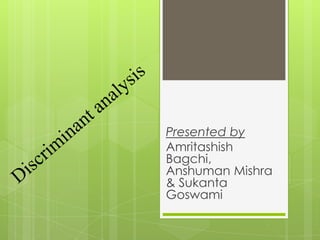
Discriminant analysis
- 1. Presented by Amritashish Bagchi, Anshuman Mishra & Sukanta Goswami
- 2. Definition Discriminant analysis is a multivariate statistical technique used for classifying a set of observations into pre defined groups. OBJECTIVE To understand group differences and to predict the likelihood that a particular entity will belong to a particular class or group based on independent variables.
- 3. Purpose 1) The main purpose is to classify a subject into one of the two groups on the basis of some independent traits. 2) A second purpose of the discriminant analysis is to study the relationship between group membership and the variables used to predict the group membership.
- 4. Situations for its use When the dependent variable is dichotomous or multichotomous. Independent variables are metric, i.e. interval or ratio.
- 5. Application of discriminant analysis To identify the characteristics on the basis of which one can classify an individual as1. basketballer or volleyballer on the basis of anthropometric variables. 2. High or low performer on the basis of skill. 3. Juniors or seniors category on the basis of the maturity parameters.
- 6. What we do in discriminant analysis It is also known as discriminant function analysis. In, discriminant analysis, the dependent variable is a categorical variable, whereas independent variables are metric. after developing the discriminant model, for a given set of new observation the discriminant function Z is computed, and the subject/ object is assigned to first group if the value of Z is less than 0 and to second group if more than 0. This criterion holds true if an equal number of observations are taken in both the groups for developing a discriminant function.
- 7. Assumptions 1. Sample size group sizes of the dependent should not be grossly different i.e. 80:20, here logistic regression may be prefer. should be at least five times the number of independent variables. 2. Normal distribution Each of the independent variable is normally distributed.
- 8. 3. Homogeneity of variances / covariances All variables have linear and homoscedastic relationships. 4. Outliers Outliers should not be present in the data. DA is highly sensitive to the inclusion of outliers. 5. Non-multicollinearity There should be any correlation among the independent variables.
- 9. 6. Mutually exclusive The groups must be mutually exclusive, with every subject or case belonging to only one group. 7. Classification Each of the allocations for the dependent categories in the initial classification are correctly classified. 8. Variability No independent variables should have a zero variability in either of the groups formed by the dependent variable.
- 10. Terminology Variables in the analysis 2) Discriminant function A discriminant function is a latent variable which is constructed as a linear combination of independent variables, such that Z= c+b1X1+ b2X2+…+bnXn The discriminant function is also known as canonical root. This discriminant function is used to classify the subject/cases into one of the two groups on the basis of the observed values of the predictor variables 1)
- 11. 3) Classification matrix In DA, it serves as a yardstick in measuring the accuracy of a model in classifying an individual /case into one of the two groups. It is also known as confusion matrix, assignment matrix,or prediction matrix. It tells us as to what percentage of the existing data points are correctly classified by the model developed in DA. 4) Stepwise method of discriminant analysis Discriminant function can be developed either by entering all independent variables together or in stepwise depending upon whether the study is confirmatory or exploratory.
- 12. 5) Power of discriminatory variables After developing the model in the discriminant analysis based on the selected independent variables, it is important to know the relative importance of the variables so selected. 6) Box’s M Test By using Box’s M Tests, we test a null hypothesis that the covariance matrices do not differ between groups formed by the dependent variable. If the Box’s M Test is insignificant, it indicates that the assumptions required for DA holds true. 7) Eigen values Eigen value is the index of overall fit.
- 13. 8) WILKS lambda It measures the efficiency of discriminant function in the model. Its value shows, how much percentage of variability in dependent variable is not explained by the independent variables. 9) Cannonial correlation The canonical correlation is the multiple correlation between the predictors and the discriminant function. With only one function it provides an index of overall model fit which is interpreted as being the proportion of variance explained (R2).
- 15. STEPS IN ANALYSIS : STEP 1. In step one the independent variables which have the discriminating power are being chosen. STEP 2. A discriminant function model is developed by using the coefficients of independent variables
- 16. STEPS IN ANALYSIS Contd… STEP 3. In step three Wilk’s lambda is computed for testing the significance of discriminant function. STEP 4. In step four the independent variables which possess importance in discriminating the groups are being found.
- 17. STEPS IN ANALYSIS Contd… STEP 5. In step five classification of subjects to their respective group is being made.
- 18. APPLICATION OF SPSS Eg. To identify the players into different categories during selection process .
- 25. Group statistics
- 26. Box's Test of Equality of Covariance Matrices
- 32. Means of the Transformed Groups Centroids Mean of group 1 Mean of group 2 (Batsmen ) (Bowler) 4.390 -4.390 0
